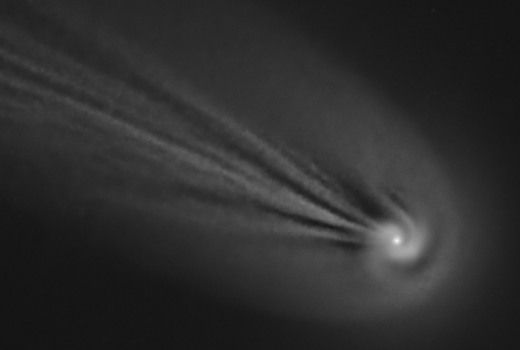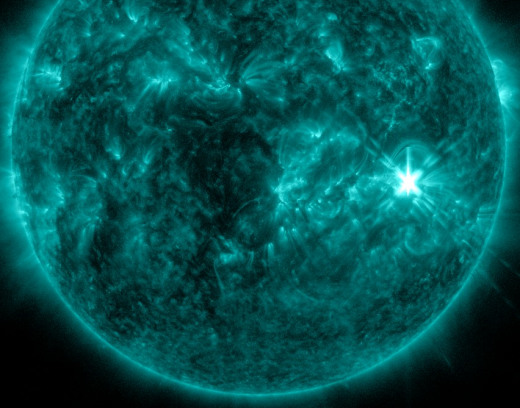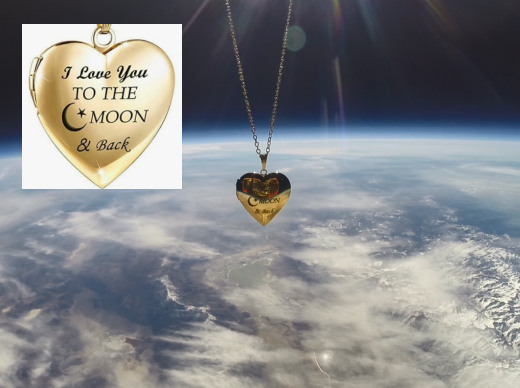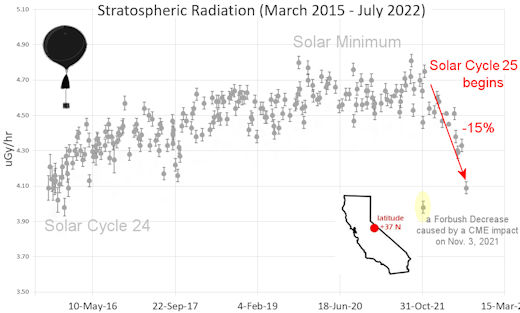This is an AI Free Zone! Text created by ChatGPT and other Large Language Models is spreading rapidly across the Internet. It's well-written, artificial, frequently inaccurate. If you find a mistake on Spaceweather.com, rest assured it was made by a real human being. | | |
THE MARTIAN SUNSPOT REPORT: NASA's Mars rover Perseverance has a good view of the farside of the sun. Today, the rover's MASTCAM is seeing three farside sunspots, two of them large. The biggest one is an old friend: giant sunspot AR3590, which has spent the last two weeks transiting the farside of the sun. It will return to the Earthside later this week; stay tuned! Solar flare alerts: SMS Text
THE SPIRAL CORE OF COMET 12P: Around the world, astronomers are monitoring Comet 12P/Pons-Brooks as it approches the sun for a close encounter in April. Most cameras are focused on the comet's magnificent tail, which is growing longer every night. Norwegian astronomer Jan Erik Vallestad decided instead to take a closer look at the comet's core--and there he found a spiral:

"The image has been processed in Pixinsight with moderate stretching to reveal structure in the core," explains Vallestad. "This is doable because the core itself was not blown out (saturated) in the original data." Other astronomers have also noticed the spiral or "yin-yang shape" of the comet's core; it appears to be real.
Evidence is mounting that 12P is "cryovolcanic." The comet's surface is peppered with geysers which spew plumes of dust and icy gas into space when fragile vents are exposed to sunlight. These exhaust plumes naturally form spirals as the comet rotates.
Realtime Comet Photo Gallery
Free: Spaceweather.com Newsletter
A SNEAKY-DANGEROUS SUNSPOT: Sunspot AR3599 doesn't look dangerous. It is relatively small and has a simple, bipolar morphology--two factors which usually add up to "harmless." Yet yesterday (March 10 @ 1213 UT), it produced a strong M7.4-class solar flare:

Extreme ultraviolet radiation radiation from the flare ionized the top of Earth's atmosphere, causing a strong shortwave radio blackout over Africa and the South Atlantic: map. Mariners and ham radio operators may have noticed loss of signal for as much as 30 minutes after the flare.
Update: The explosion did produce a CME traveling ~750 km/s (1.7 million mph). The faint cloud will mostly miss Earth, passing ahead of our planet in its orbit. However, a NASA model suggests there could be a glancing blow late on March 13th. Minor G1-class geomagnetic storms are possible on that date. Aurora alerts: SMS Text
Realtime Space Weather Photo Gallery
Free: Spaceweather.com Newsletter
18K GOLD "LOVE YOU TO THE MOON" LOCKET: This is a very special locket. It's heart-shaped, plated with 18K gold, and we will fly it again during this year's total eclipse of the sun. Keep reading...
On Jan. 26, 2024, the students of Earth to Sky Calculus launched this locket to the stratosphere onboard a cosmic ray research balloon. At the apex of the flight, it floated 111,535 feet above the Sierra Nevada mountains of central California:

Buy it now for $149.95, and we'll fly it again--FOR FREE--during the total solar eclipse on April 8, 2024. The students will be launching multiple balloons from the path of totality in Texas. Your pendant will go along for the ride, touching the shadow of the Moon at the edge of space. (Simply type "FLY IT AGAIN" in the comments box at checkout.)
The locket, which opens to hold a personal photo or other small item, comes with a greeting card showing the jewelry in flight and telling the story of its journey to the edge of space.
Far Out Gifts: Earth to Sky Store
All sales support hands-on STEM education
Realtime Aurora Photo Gallery
Free: Spaceweather.com Newsletter
Realtime Comet Photo Gallery
Free: Spaceweather.com Newsletter
Every night, a network of
NASA all-sky cameras scans the skies above the United States for meteoritic fireballs. Automated software maintained by NASA's Meteoroid Environment Office calculates their orbits, velocity, penetration depth in Earth's atmosphere and many other characteristics. Daily results are presented here on Spaceweather.com.
On Mar 10, 2024, the network reported 3 fireballs.
(3 sporadics)

In this diagram of the inner solar system, all of the fireball orbits intersect at a single point--Earth. The orbits are color-coded by velocity, from slow (red) to fast (blue). [Larger image] [movies]
Potentially Hazardous Asteroids (
PHAs) are space rocks larger than approximately 100m that can come closer to Earth than 0.05 AU. None of the known PHAs is on a collision course with our planet, although astronomers are finding
new ones all the time.
On March 11, 2024 there were 2349 potentially hazardous asteroids.
 |
Recent & Upcoming Earth-asteroid encounters: | Asteroid | Date(UT) | Miss Distance | Velocity (km/s) | Diameter (m) |
| 2024 EH | 2024-Mar-07 | 1.3 LD | 9.5 | 13 |
| 2024 EJ2 | 2024-Mar-08 | 1.5 LD | 14.8 | 18 |
| 2024 ET1 | 2024-Mar-08 | 2.5 LD | 12 | 7 |
| 2024 DW1 | 2024-Mar-08 | 10.5 LD | 19.9 | 61 |
| 2024 EY1 | 2024-Mar-08 | 6 LD | 7.7 | 8 |
| 2024 EZ1 | 2024-Mar-08 | 6.8 LD | 6.3 | 15 |
| 2024 EO | 2024-Mar-09 | 3.6 LD | 19.2 | 19 |
| 2024 EG | 2024-Mar-09 | 8.4 LD | 19.2 | 45 |
| 2024 EQ1 | 2024-Mar-09 | 6.6 LD | 17.1 | 34 |
| 2024 EA2 | 2024-Mar-10 | 5.5 LD | 11 | 12 |
| 2024 EE2 | 2024-Mar-10 | 13.9 LD | 18.7 | 38 |
| 2024 DA1 | 2024-Mar-11 | 9.4 LD | 9.9 | 49 |
| 2024 EG2 | 2024-Mar-12 | 1.7 LD | 19.6 | 22 |
| 2015 FM34 | 2024-Mar-12 | 19.4 LD | 11.1 | 113 |
| 2024 EL1 | 2024-Mar-13 | 8.5 LD | 7.9 | 19 |
| 2020 FU | 2024-Mar-15 | 14.9 LD | 15.5 | 19 |
| 2024 CJ8 | 2024-Mar-16 | 17.3 LD | 12.1 | 81 |
| 2024 EQ | 2024-Mar-16 | 6.9 LD | 10.7 | 22 |
| 2024 EK | 2024-Mar-16 | 7 LD | 7.6 | 16 |
| 2024 EX2 | 2024-Mar-16 | 5.8 LD | 6.2 | 20 |
| 2024 EN | 2024-Mar-18 | 3.9 LD | 12 | 43 |
| 2020 FD | 2024-Mar-18 | 4.5 LD | 15.1 | 10 |
| 2024 BD7 | 2024-Mar-19 | 18.8 LD | 10.1 | 140 |
| 2019 CJ | 2024-Mar-24 | 12.4 LD | 4.4 | 28 |
| 2021 CF6 | 2024-Mar-25 | 14.6 LD | 8.3 | 62 |
| 2023 RO49 | 2024-Mar-29 | 14.1 LD | 4.3 | 45 |
| 2015 MB54 | 2024-Mar-30 | 11.7 LD | 3.8 | 54 |
| 2024 DQ | 2024-Mar-30 | 6.4 LD | 2.9 | 41 |
| 2018 CC14 | 2024-Apr-03 | 19.6 LD | 8.9 | 115 |
| 2023 GC2 | 2024-Apr-04 | 8.7 LD | 5.7 | 12 |
| 2005 FG | 2024-Apr-08 | 18.4 LD | 5.5 | 57 |
| 2020 BP13 | 2024-Apr-09 | 15.2 LD | 6.8 | 209 |
| 2021 RJ19 | 2024-Apr-12 | 19.6 LD | 11.4 | 25 |
| 2021 GQ5 | 2024-Apr-13 | 8.8 LD | 7.5 | 7 |
| 2023 FN13 | 2024-Apr-14 | 3.3 LD | 4.9 | 13 |
| 2022 UO1 | 2024-Apr-14 | 16.7 LD | 14 | 33 |
| 517681 | 2024-Apr-15 | 18.4 LD | 14.2 | 589 |
| 439437 | 2024-Apr-15 | 8.5 LD | 16.5 | 609 |
| 2023 HU3 | 2024-Apr-18 | 15.9 LD | 19.1 | 35 |
| 2021 JW2 | 2024-Apr-19 | 1.6 LD | 5.1 | 11 |
| 2017 SA20 | 2024-Apr-19 | 3.8 LD | 6.2 | 8 |
| 2021 VH2 | 2024-Apr-25 | 9.3 LD | 2.7 | 6 |
| 2021 GD3 | 2024-Apr-30 | 11.4 LD | 3.5 | 14 |
| 2022 TN1 | 2024-Apr-30 | 18.6 LD | 17.7 | 295 |
| 2022 AA5 | 2024-May-02 | 12 LD | 8.9 | 67 |
Notes: LD means "Lunar Distance." 1 LD = 384,401 km, the distance between Earth and the Moon. 1 LD also equals 0.00256 AU. | | Cosmic Rays in the Atmosphere |
SPACE WEATHER BALLOON DATA: Almost once a week, Spaceweather.com and the students of Earth to Sky Calculus fly space weather balloons to the stratosphere over California. These balloons are equipped with sensors that detect secondary cosmic rays, a form of radiation from space that can penetrate all the way down to Earth's surface. Our monitoring program has been underway without interruption for 7 years, resulting in a unique dataset of in situ atmospheric measurements.
Latest results (July 2022): Atmospheric radiation is decreasing in 2022. Our latest measurements in July 2022 registered a 6-year low:

What's going on? Ironically, the radiation drop is caused by increasing solar activity. Solar Cycle 25 has roared to life faster than forecasters expected. The sun's strengthening and increasingly tangled magnetic field repels cosmic rays from deep space. In addition, solar coronal mass ejections (CMEs) sweep aside cosmic rays, causing sharp reductions called "Forbush Decreases." The two effects blend together to bring daily radiation levels down.
.Who cares? Cosmic rays are a surprisingly "down to Earth" form of space weather. They can alter the chemistry of the atmosphere, trigger lightning, and penetrate commercial airplanes. According to a study from the Harvard T.H. Chan school of public health, crews of aircraft have higher rates of cancer than the general population. The researchers listed cosmic rays, irregular sleep habits, and chemical contaminants as leading risk factors. A number of controversial studies (#1, #2, #3, #4) go even further, linking cosmic rays with cardiac arrhythmias and sudden cardiac death.
Technical notes: The radiation sensors onboard our helium balloons detect X-rays and gamma-rays in the energy range 10 keV to 20 MeV. These energies span the range of medical X-ray machines and airport security scanners.
Data points in the graph labeled "Stratospheric Radiation" correspond to the peak of the Regener-Pfotzer maximum, which lies about 67,000 feet above central California. When cosmic rays crash into Earth's atmosphere, they produce a spray of secondary particles that is most intense at the entrance to the stratosphere. Physicists Eric Regener and Georg Pfotzer discovered the maximum using balloons in the 1930s and it is what we are measuring today.
| | The official U.S. government space weather bureau |
| | The first place to look for information about sundogs, pillars, rainbows and related phenomena. |
| | Researchers call it a "Hubble for the sun." SDO is the most advanced solar observatory ever. |
| | 3D views of the sun from NASA's Solar and Terrestrial Relations Observatory |
| | Realtime and archival images of the Sun from SOHO. |
| | information about sunspots based on the latest NOAA/USAF Active Region Summary |
| | current counts of failed and deployed Starlink satellites from Jonathan's Space Page |
| | Authoritative predictions of space junk and satellite re-entries |
| | from the NOAA Space Environment Center |
| | fun to read, but should be taken with a grain of salt! Forecasts looking ahead more than a few days are often wrong. |
| | from the NOAA Space Environment Center |
| | the underlying science of space weather |
 | When looking for casinos to play online when the weather is bad, you can try the SkyCity Online Casino if you are located in New Zealand. If you are not from NZ you can try the Swedish page Svenska casino online to find suitable games, check out svenskacasinoonline.net. Always check your local laws before playing with real money.. |
 | BestCSGOGambling is the best site for everything related to CSGO gambling on the web |
| | These links help Spaceweather.com stay online. Thank you to our supporters! |
| | | | | | |

